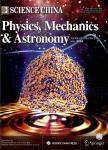Narrow line Seyfert 1 galaxies: where are the broad line regions?
Narrow line Seyfert 1 galaxies: where are the broad line regions?作者机构:Key Laboratory of Optical Astronomy National Astronomical Observatories Chinese Academy of Sciences Beijing China Key Laboratory for Particle Astrophysics Institute of High Energy Physics Chinese Academy of Sciences Beijing China Graduate University of the Chinese Academy of Sciences Beijing China Department of Physics Nanjing Normal University Nanjing China
出 版 物:《Science China(Physics,Mechanics & Astronomy)》 (中国科学:物理学、力学、天文学(英文版))
年 卷 期:2010年第53卷第12期
页 面:2307-2311,2339-2343页
核心收录:
学科分类:07[理学] 070401[理学-天体物理] 0704[理学-天文学]
基 金:supported by the National Natural Science Foundation of China (GrantNos. 10733010, 10821061, 10903008 and 10873010), the CAS-KJCX2-YW-T03 the National Basic Research Program of China (Grant Nos.2009CB824800 and 2007CB815103)
主 题:black hole physics galaxies: evolution quasars: general
摘 要:A sample consisting of 211 narrow line Seyfert 1 galaxies (NLS1s) with high quality spectra from the Sloan Digital Sky Survey (SDSS) is selected to explore where broad line regions are in these objects. We find that the Hβ profile can be fitted well by three (narrow, intermediate and broad) Gaussian components, and the FWHM ratios of the broad to the intermediate components hold a constant of 3.0 roughly for the entire sample. If the broad components originate from the region scaled by the well-determined Hβ reverberation mapping relation, we find that the intermediate components originate from the inner edge of the torus, which is scaled by dust K-band reverberation. We find that the IC and the BC are strongly linked dynamically, but the relation of their covering factors is much more relaxed, implying that both regions are clumpy.



